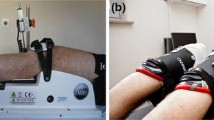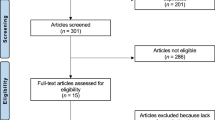Abstract
Background and purpose
Anterior knee laxity can be evaluated using different devices, the most commonly used being the Telos®, KT1000®, Rolimeter®, and GNRB®. However, the laxity values obtained with these devices have never been compared to one another. As such, the outcomes of studies using these different knee laxity measurement devices may not be comparable. The primary purpose of this study was to determine the side-to-side laxity difference in patients with one ACL-injured knee, using each of these devices, and to compare the values obtained from each. We hypothesized that the measurements of laxity would vary depending on the device used.
Methods
This was a prospective study. All patients with an ACL injury, in which surgical reconstruction was planned, underwent pre-operative knee laxity measurements using four different devices. The concordance correlation coefficient (CCC) of the results was compared between the four devices.
Results
The study enrolled 52 patients. With regard to the values of the side-to-side differences, the KT1000® and the GNRB® obtained the most similar values (CCC = 0.51, 95% CI 0.37–0.63). The two devices with the lowest correlation were the Telos® and the Rolimeter® (CCC = 0.04, 95% CI − 0.14–0.23). The comparability was considered average for the KT1000® and GNRB® and poor for the other devices.
Conclusions
The knee laxity devices used in regular practice are not comparable to one another. As a result, caution must be taken when comparing results from studies using these different devices.






Similar content being viewed by others
References
Balasch H, Schiller M, Friebel H, Hoffmann F (1999) Evaluation of anterior knee joint instability with the Rolimeter. A test in comparison with manual assessment and measuring with the KT-1000 arthrometer. Knee Surg Sports Traumatol Arthrosc 7:204–208
Ballantyne BT, French AK, Heimsoth SL, Kachingwe AF, Lee JB, Soderberg GL (1995) Influence of examiner experience and gender on interrater reliability of KT-1000 arthrometer measurements. Phys Ther 75:898–906
Beldame J, Mouchel S, Bertiaux S, Adam JM, Mouilhade F, Roussignol X et al (2012) Anterior knee laxity measurement: comparison of passive stress radiographs Telos((R)) and “Lerat”, and GNRB((R)) arthrometer. Orthop Traumatol Surg Res 98:744–750
Bouguennec N, Odri GA, Graveleau N, Colombet P (2015) Comparative reproducibility of TELOS and GNRB(R) for instrumental measurement of anterior tibial translation in normal knees. Orthop Traumatol Surg Res 101:301–305
Boyer P, Djian P, Christel P, Paoletti X, Degeorges R (2004) Reliability of the KT-1000 arthrometer (Medmetric) for measuring anterior knee laxity: comparison with Telos in 147 knees. Rev Chir Orthop Reparatrice Appar Mot 90:757–764
Collette M, Courville J, Forton M, Gagniere B (2012) Objective evaluation of anterior knee laxity; comparison of the KT-1000 and GNRB(R) arthrometers. Knee Surg Sports Traumatol Arthrosc 20:2233–2238
Di Iorio A, Carnesecchi O, Philippot R, Farizon F (2014) Multiscale analysis of anterior cruciate ruptures: prospective study of 49 cases. Orthop Traumatol Surg Res 100:751–754
Forster IW, Warren-Smith CD, Tew M (1989) Is the KT1000 knee ligament arthrometer reliable? J Bone Joint Surg Br 71:843–847
Ganko A, Engebretsen L, Ozer H (2000) The rolimeter: a new arthrometer compared with the KT-1000. Knee Surg Sports Traumatol Arthrosc 8:36–39
Garces GL, Perdomo E, Guerra A, Cabrera-Bonilla R (1995) Stress radiography in the diagnosis of anterior cruciate ligament deficiency. Int Orthop 19:86–88
Graham GP, Johnson S, Dent CM, Fairclough JA (1991) Comparison of clinical tests and the KT1000 in the diagnosis of anterior cruciate ligament rupture. Br J Sports Med 25:96–97
James EW, Williams BT, LaPrade RF (2014) Stress radiography for the diagnosis of knee ligament injuries: a systematic review. Clin Orthop Relat Res 472:2644–2657
Jardin C, Chantelot C, Migaud H, Gougeon F, Debroucker MJ, Duquennoy A (1999) Reliability of the KT-1000 arthrometer in measuring anterior laxity of the knee: comparative analysis with Telos of 48 reconstructions of the anterior cruciate ligament and intra- and interobserver reproducibility. Rev Chir Orthop Reparatrice Appar Mot 85:698–707
Lefevre N, Bohu Y, Naouri JF, Klouche S, Herman S (2014) Validity of GNRB(R) arthrometer compared to Telos in the assessment of partial anterior cruciate ligament tears. Knee Surg Sports Traumatol Arthrosc 22:285–290
Lerat JL, Moyen B, Jenny JY, Perrier JP (1993) A comparison of pre-operative evaluation of anterior knee laxity by dynamic X-rays and by the arthrometer KT 1000. Knee Surg Sports Traumatol Arthrosc 1:54–59
Lorbach O, Kieb M, Brogard P, Maas S, Pape D, Seil R (2012) Static rotational and sagittal knee laxity measurements after reconstruction of the anterior cruciate ligament. Knee Surg Sports Traumatol Arthrosc 20:844–850
Markolf KL, Graff-Radford A, Amstutz HC (1978) In vivo knee stability. A quantitative assessment using an instrumented clinical testing apparatus. J Bone Joint Surg Am 60:664–674
Panisset JC, Ntagiopoulos PG, Saggin PR, Dejour D (2012) A comparison of Telos stress radiography versus Rolimeter in the diagnosis of different patterns of anterior cruciate ligament tears. Orthop Traumatol Surg Res 98:751–758
Pierrat B, Oullion R, Molimard J, Navarro L, Combreas M, Avril S et al (2015) Characterisation of in-vivo mechanical action of knee braces regarding their anti-drawer effect. Knee 22:80–87
Pugh L, Mascarenhas R, Arneja S, Chin PY, Leith JM (2009) Current concepts in instrumented knee-laxity testing. Am J Sports Med 37:199–210
Robert H, Nouveau S, Gageot S, Gagniere B (2009) A new knee arthrometer, the GNRB: experience in ACL complete and partial tears. Orthop Traumatol Surg Res 95:171–176
Sernert N, Helmers J, Kartus C, Ejerhed L, Kartus J (2007) Knee-laxity measurements examined by a left-hand- and a right-hand-dominant physiotherapist, in patients with anterior cruciate ligament injuries and healthy controls. Knee Surg Sports Traumatol Arthrosc 15:1181–1186
Wiertsema SH, van Hooff HJ, Migchelsen LA, Steultjens MP (2008) Reliability of the KT1000 arthrometer and the Lachman test in patients with an ACL rupture. Knee 15:107–110
Author information
Authors and Affiliations
Corresponding author
Ethics declarations
This study was approved by the national ethics committee (No. 2015-A00423-46). It was also approved by the national health authority (DMDPT-DIAG/MM/2015-A00423-46).
Conflicts of interest
The authors declare that they have no conflict of interest.
Additional information
Level of evidence: 2, Diagnostic study.
Rights and permissions
About this article
Cite this article
Murgier, J., Béranger, J.S., Boisrenoult, P. et al. Prospective comparative study of knee laxity with four different methods in anterior cruciate ligament tears. International Orthopaedics (SICOT) 42, 1845–1851 (2018). https://doi.org/10.1007/s00264-018-3791-4
Received:
Accepted:
Published:
Issue Date:
DOI: https://doi.org/10.1007/s00264-018-3791-4




